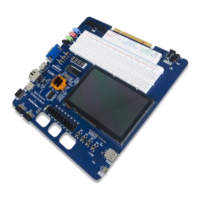16 | ni.com | NI Digital System Development Board User Manual
microSD Boot Mode
The DSDB supports booting from a microSD card inserted into connector J15. The following
procedure will allow you to boot the Zynq from microSD:
1. Format the microSD card with a FAT32 file system.
2. Copy the Zynq Boot Image created with Xilinx SDK to the microSD card.
3. Rename the Zynq Boot Image on the microSD card to BOOT.bin.
4. Eject the microSD card from your computer and insert it into connector J15 on the DSDB.
5. Set SW8 to
SD.
6. Turn the board on. The board will now boot the image on the microSD card.
Quad-SPI Boot Mode
The DSDB has an onboard 128-Mbit Quad-SPI serial Flash that the Zynq can boot from. Vivado
and Xilinx SDK can be used to generate a Zynq boot image and program it into the Quad-SPI
flash using the USB-JTAG port. Once a boot image has been programmed into the Quad-SPI
flash, do the following to boot the DSDB:
1. Set SW8 to QSPI.
2. Turn the board on. The board will now boot the image stored in the Quad-SPI flash.
JTAG Boot Mode
When placed in JTAG boot mode, the processor will wait until software is loaded by a host
computer using the Xilinx tools. After software has been loaded, it is possible to either let the
software begin executing, or step through it line by line using Xilinx SDK.
It is also possible to directly configure the PL over JTAG, independent of the processor. This can
be done using iMPACT or the Vivado Hardware Server.
The DSDB is configured to boot in Cascaded JTAG mode, which allows the PS to be accessed
via the same JTAG port as the PL. It is also possible to boot the DSDB in Independent JTAG
mode by loading a jumper in JP1 and shorting it. This will cause the PS to not be accessible from
the onboard JTAG circuitry, and only the PL will be visible in the scan chain. To access the PS
over JTAG while in independent JTAG mode, users will have to route the signals for the PJTAG
peripheral over EMIO, and use an external device to communicate with it.
Connecting to NI ELVIS
The DSDB is fully integrated with the NI ELVIS platform, which features 12 of the most
commonly used instruments in the laboratory including an oscilloscope, digital multimeter,
function generator, variable power supplies, digital reader/writer, two- and three-wire
current-voltage analyzers, and a Bode analyzer. Integration with the NI ELVIS platform gives
students the ability to build comprehensive test benches and analog mixed-signal circuits that
can be designed and tested in one platform. The DSDB is also capable of running standalone
when the advanced functionality of the NI ELVIS is not required.

